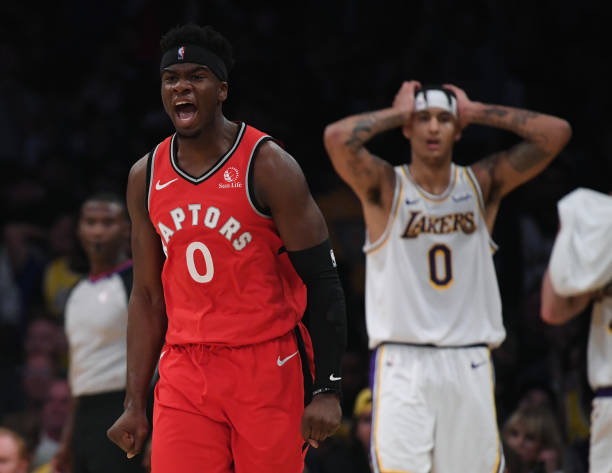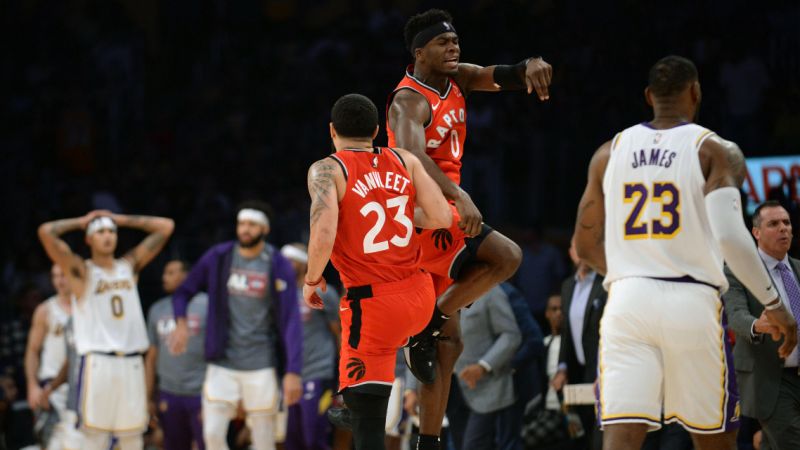Championship teams find ways to win games that they have no business winning, as the Toronto Raptors did against the Los Angeles Lakers on Sunday night. The Raptors may not have the same roster as they had last year, but they still have the same swagger and winning identity. The Lakers are supposed to be a championship contender, and the Raptors — especially without Kyle Lowry and Serge Ibaka — are not considered to be within the same vaunted tier. That didn’t matter at all in Toronto’s frantic 113-104 victory over Los Angeles. Toronto turned their weaknesses into strengths in toppling the Goliath Lakers.
Pundits talk about championship DNA. But what do they really mean? Here’s the blueprint.
Coaching capers
Toronto’s offense was at a massive disadvantage entering the game. The Raptors were missing their most important offensive player, Kyle Lowry, the elite point guard who makes everyone else’s shots easier and scores plenty of efficient buckets on his own. And they were missing Serge Ibaka, one of the best scorers and rim protectors on the team. The Lakers, on the other hand, boasted the league’s best defense, primarily boosted by the fact that they start three mega-giants who take up absurd amounts of space on the floor and have 20+ feet of arms contesting anything near the rim. Pascal Siakam struggled against his primary defender, Anthony Davis, and Toronto’s half-court offense was the equivalent of a leaky garbage bag for much of the first half. Nick Nurse and company provided some solutions during the break.
Davis was a nightmare for Siakam, so Toronto needed to force some switches. In the Raptors’ first three offensive possessions in the half-court of the second half, they ran the little-seen 4-2 pick-and-roll, another 4-2, followed by the more traditional 1-4. The requirements were for Siakam to be involved, as well as another scoring threat — eliminating Marc Gasol — but not whomever was guarded by LeBron James — eliminating OG Anuonby. So Siakam and either Fred VanVleet or Norm Powell danced their way to freedom, and it worked exceptionally well. Toronto scored five points in those three possessions.
It continued into the fourth quarter, when Terence Davis filled the role of Powell. The Raptors showed great poise in that it wasn’t always Siakam himself scoring against switches, but instead using the created advantages to manufacture good looks for teammates.
Nurse was faced with a loss if he coached a normal game. He had to solve the problems presented by the Lakers with creativity. Nurse’s shenanigans worked, getting Siakam lots of switches against weaker defenders. Which leads to the next point.
Eat when there’s food
Do you remember when people used to think Kyle Kuzma was a better basketball player than Siakam? Hopefully that’s over forever. Matchup data has Kuzma guarding Siakam for 7.7 possessions, or 1:40 of time in the game. Siakam went back for seconds at the Kuzma buffet in that short time, though, scoring 18 points on 7-of-7 shooting. Siakam drove in transition, or spun in the post, and generally attacked Kuzma with casual ferocity. Kuzma is a nice offensive prospect, but he doesn’t have the quickness, strength, or length to compete with Siakam. It was a basketball beatdown of the highest order.
Siakam ate Kuzma’s heart, over and over, like the eagle feasting on Prometheus, but consuming instead a slightly more vital organ. Siakam’s feast wasn’t just for show. Siakam’s destruction of Kuzma was completely necessary for the Raptors to win. Against Davis, in 26.7 possessions, Siakam shot 0-for-7. Aside from beautiful seven-attempt symmetry, that’s eye-opening. Davis is a phenomenal defender, and he made Siakam’s night extremely difficult. It was all the more impressive that Siakam didn’t stay cold when given the opportunity to erupt. He still got his points, compressing his chances into two minutes dotted throughout the game. That’s the mark of a brilliant offensive basketball player alongside a creative coach.
Run, run, run
Schemes can only fix so many half-court woes when the problems are structural. Toronto was never going to thrive in the half-court, even if they at least became feisty after the half. The Raptors needed somewhere to really bank some points, and they found that on the break. The Lakers may have a bunch of long defenders, but they don’t have as many defenders known for their defensive intelligence and effort. Toronto pushed the Lakers to their limits by running at every opportunity, and they found limitless buckets. They ran after steals and blocks, misses, and sometimes even after makes. Toronto scored 32 fast-break points, and in a game where scoring was often a struggle, that was enough.
Toronto knew great shots would be hard to find. Any good shot, even four seconds into the clock, was green-lighted from jump street. Not only did that give VanVleet room for success on the break, but it also helped Toronto’s bench performers find rhythm as they played big minutes for the first time of the season.
Bench business
Rondae Hollis-Jefferson, Chris Boucher, and Terence Davis combined for 38 points. They all notched season highs in minutes and corresponding season highs in scoring. It’s easier to play well when you know you have a longer leash, but some of the success they found was almost absurd.
Davis is not supposed to have that in his arsenal, at least not yet. His monstrous put-back dunk in the fourth quarter? That’s much more his speed.
There were multiple explanations for why Toronto’s bench thrived. For one, they played the majority of their minutes alongside Siakam when Anthony Davis was not in the game for the Lakers. That was a recipe for Lakers’ disaster, and Siakam didn’t disappoint. A lineup of Matt Thomas, Davis, Hollis-Jefferson, Siakam, and Boucher was Toronto’s second-most used lineup, notching 6.3 minutes. It was also Toronto’s best lineup, outscoring the Lakers by nine in that time. The bench also played terrific defense and got out in transition. Hollis-Jefferson finally got real time, and he should be a rotation piece, even when Toronto is healthy. He’s talented and plays with the intelligence that Toronto values highly. So there were lots of replicables, even if the final numbers from the bench were a little out of the ordinary. They won by running, rebounding the ball on the offensive end, and blocking every Lakers’ shot in sight.
Preserving the Paint
Every play counts the same in the box score, but plenty of moments count for extra in the box score of the heart. Complete and utter annihilation of opponents with blocked shots constitute such momentum swings. And woah baby did Toronto get some crushing done on the defensive end.
It wasn’t just blocks. OG Anunoby was brilliant, as always, against LeBron James. In 16.7 possessions with Anunoby as James’s primary defender, James shot 0-for-1; Anunoby not only limited his scoring, but he took him out of the game almost entirely. James had 1 point and 1 assist in those 4:17 minutes of time in the game. Anunoby is ready to step into Kawhi Leonard’s shoes and defend the best players in the world.
The Raptors did even more to protect the paint outside of traditional position orientations. The Raptors a few times saw guards matched up against Javale McGee down low, and Powell and VanVleet both recorded incredible steals while breaking up the entry passes. Every player being able to switch onto different positions is part of what makes Toronto such a good team, even without Lowry or Ibaka.
The Lakers still shot 20-of-33 in the restricted area, which is a fairly good number, if not excellent. It was Toronto’s ability to keep the Lakers out of the paint that was the most important element defensively. Shot-blocking was not the most important factor there; Toronto’s defense was not entirely premised on the raw humiliation of blocking shots. Credit VanVleet and Anunoby, then, as much as Boucher or Siakam in defending the paint. There were some replicable elements, even if they weren’t traditional.
Zone Zealotry
The Raptors had to get funky to force the Lakers into poor shots. The Lakers are massive, with plenty of scoring, size, and finishing ability. They lack creators with tight handles, so Toronto bet for a long stretch of the game that the Lakers would struggle to create good looks against the Raptors’ patented zone.
The Lakers are most dangerous in motion, when their superstars in Davis and James can pick apart a defense and boost the performances of their teammates. Against a zone, the Lakers struggled because their collection of wings — none of whom can dribble even a lick — are asked to create a little bit for themselves. It did not work well, and the Lakers frequently devolved into mid-range attempts or committed heaps of turnovers. Toronto’s zone was one of the most important elements in keeping the Lakers out of the paint. Toronto’s zone has been a real weapon for some time now, and they used it for long stretches last year during the regular season and playoffs. It’s a known quantity at this point, even if it isn’t traditionally used in the NBA. Against teams like the Lakers, the Raptors will always have it in the back-pocket to throw mud in the game’s eyes whenever necessary.
Conclusions
Never underestimate the heart of a champion. Still, there were some elements of Toronto’s win over the Lakers that cannot be relied upon in the future. Chris Boucher will not always be the best player on the floor for extended stretches. Terence Davis probably isn’t going to hit step-back triples every night. But like any pointillist masterpiece, the specifics are less important than the whole that they create.
The general premises, the bird’s-eye view shows a clear picture. Toronto won behind incredible coaching replete with half-time adjustments, energy and defense across the roster, and star performances from their best players. Those qualities carry over no matter who is in Toronto’s lineup, established stars like Lowry and Ibaka, or unproven projects like Davis and Boucher. And what else is a better description of championship DNA?



